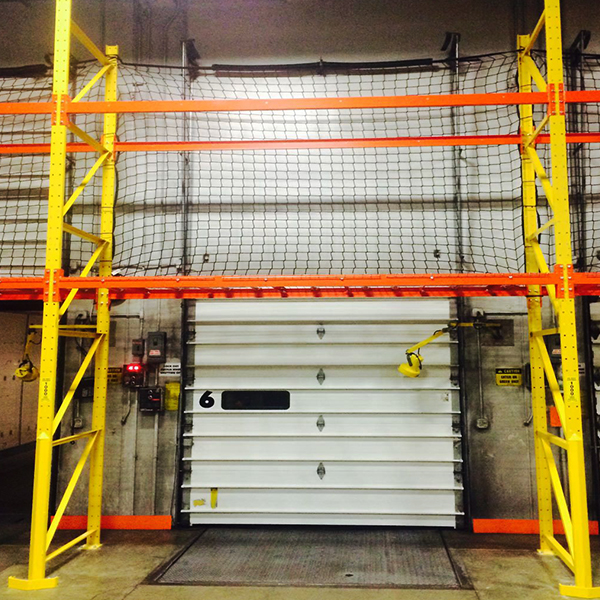Over-The-Dock Racking: Special Considerations For Busy Loading Zones

When it comes to optimizing space in a warehouse, distribution center, or production facility, safety should always be the top priority. One often overlooked area that can provide a cost-effective solution for the need for additional storage is above the dock doors. Although inbound and outbound dock areas are a hub of activity, a properly engineered and protected rack structure can leverage the unused area above the dock doors to free up floorspace. For operations thinking of using over-the-dock racking, here are a few special considerations for their safe application in busy loading zones.

Consideration # 1: What Are the Stored Items.
Many operations utilize over-the-dock racking to store items that are useful to have near the dock. Often, this is an ideal place to put empty pallets, said Dawn Bigbee, Design Supervisor at NUCOR Warehouse Systems, a member of the Rack Manufacturers Institute (RMI).
“We often see over-the-dock racking used to hold pallets that are waiting for a return trip to a customer or a vendor,” she said. “This helps open up floorspace in the dock area by allowing them to be stored overhead.”
Likewise, other operations use over-the-dock racking to store excess inventory of packing and shipping materials, Bigbee continued. “I’ve also seen operations use this as the spot to store facility-related items, like extra lightbulbs. It’s a good location for long-term storage of items that don’t require frequent access or movement.”
Consideration # 2: Structural Capacity of the Rack Configuration.
As with every rack installation, safety is paramount when implementing over-the-dock racking. Bigbee urged operations considering this solution work with a qualified rack design engineer to ensure the safest structure.
There are three typical over-the-dock storage rack solutions available. Conventional single-deep selective pallet rack with uprights located on either side of the dock doors. The first level of storage beams and decking are immediately above the doors.
However, because of the heavy forklift traffic passing in and out of the dock doors when loading and unloading trailers, many operations prefer to minimize impact risk. There are two rack design alternatives that can accomplish that goal in busy loading zones, said Bigbee: single-leg pallet rack and suspended pallet rack.
“In both of these situations, however, the rack must tie in to the building wall,” she explained. “That makes the design of these two types of over-the-dock racking more complicated structurally, because now the loading forces will be applied to the wall. That additional load can damage the building’s structure.”
To safely and properly design these styles of rack requires consultation with the building’s original structural engineer. That can be challenging when working with an existing building, she said.
“It may not always be possible to locate the facility’s structural engineer — particularly in an older building,” Bigbee noted. “If you can find that person, they need to confirm that the building’s walls can handle the applied loads imparted by the rack. But it’s often challenging, particularly in older facilities.”
For that reason, the optimal time to plan for single-leg or suspended over-the-dock racking is during the design phase of a new facility. Regardless of whether using over-the-dock racking in a new building or as a retrofit, the rack structure will need permits issued by the local jurisdiction.
Consideration # 3: Protecting Uprights and Personnel.
Installing safety and containment accessories will help protect the racking from forklift impacts and prevent items from falling into the busy loading area.
Pallet rack column guards — offered in a variety of configurations — deflect impacts. Bollards and guardrails are free-standing versions of these protective guarding devices. They are installed on the floor a few inches in front of the uprights. Other column protection options are either bolted or welded to the column.
Outfitting over-the-dock racking with flexible safety nets or rigid steel mesh panels protects personnel working in the area from falling items. These containment accessories capture any items before they tumble to the floor.
“Like all other industrial steel storage rack installations, plan for routine inspections of over-the-dock racking for damage,” added Bigbee. Because these racks will be in a high-traffic area, inspections should occur daily to identify dents, missing safety pins, loose anchor bolts, and more. Immediately isolate the area until repairs are complete.
Want More Pallet Rack Safety Guidance?
RMI offers multiple resources detailing both standards and best practices that enhance people and pallet rack safety. This includes a series of videos, presentations, publications, case studies, frequently asked questions, and an MHI Cast podcast recording about rack safety.




